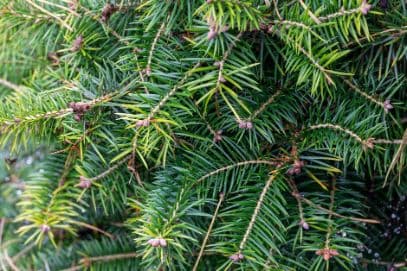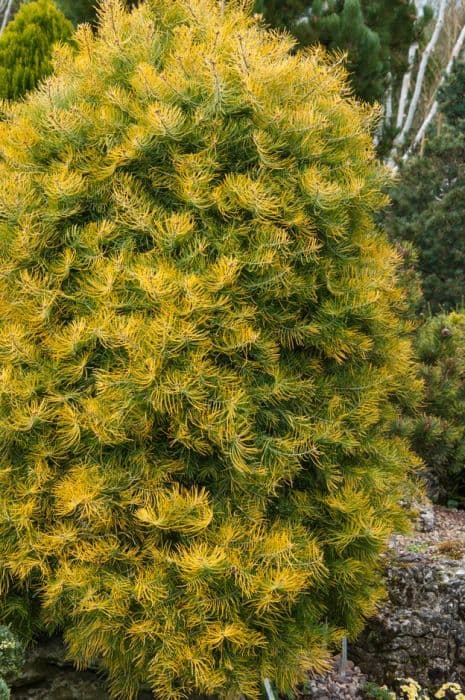Korean fir Abies koreana

ABOUT
Abies koreana, commonly known as Korean fir, is a coniferous evergreen with a symmetrical pyramidal shape that conveys a distinctive ornamental aesthetic. The foliage consists of shiny, dark green needles that are short and arranged in a somewhat radial pattern around the branches, giving the tree a full and lush appearance. The needles often have a silver-white underside, which creates a beautiful two-toned effect. One of the most striking features of the Korean fir is its vibrant purple cones that stand upright on the branches, contrasting sharply with the green foliage. These cones are especially decorative and can add visual interest to the plant throughout the year, as they mature to a brown color with age. The bark of the Korean fir is smooth and gray when the plant is young, and it becomes more furrowed and scaly as it matures. Overall, the Korean fir presents a very neat and compact appearance, with dense branches that provide excellent cover and make it a favorite for use in landscapes as an ornamental tree. The attractive foliage and unique cones make this plant a standout addition to any garden setting, offering year-round visual appeal.
About this plant
 Names
NamesFamily
Pinaceae.
Synonyms
Korean Fir, Korean Abies.
Common names
Abies koreana.
 Toxicity
ToxicityTo humans
The Korean fir is generally considered non-toxic to humans. However, if any parts of the plant are ingested, they can be irritating to the mouth and stomach, potentially causing mild gastrointestinal upset. The needles might be sharp and could cause physical irritation or discomfort if handled improperly. There is no significant toxicity associated with this plant for humans, and poisoning is rare.
To pets
The Korean fir is not known to be highly toxic to pets, but as with most plants, it can cause gastrointestinal upset such as vomiting or diarrhea if ingested in significant amounts. The needles can also be irritating to the mouth and digestive tract. It is recommended to keep an eye on pets around this plant to prevent ingestion of needles or other parts of the tree that might lead to physical discomfort or mild gastrointestinal symptoms.
 Characteristics
CharacteristicsLife cycle
Perennials
Foliage type
Evergreen
Color of leaves
Green
Height
10-50 feet (3-15 meters)
Spread
10-20 feet (3-6 meters)
Plant type
Tree
Hardiness zones
5-7
Native area
Korea
Benefits
 General Benefits
General Benefits- Aesthetic Appeal - Abies koreana, commonly known as Korean fir, has attractive, dark green foliage and a symmetrical conical shape that enhances landscape beauty.
- Ornamental Cones - Korean fir is noted for its violet-blue cones that add ornamental interest to gardens and landscapes.
- Habitat for Wildlife - Provides shelter and nesting sites for birds and other wildlife.
- Shade Provider - Its dense foliage offers a cool shade, making it a desirable tree for parks and large gardens.
- Low Maintenance - Once established, it requires minimal care, making it a good choice for those who prefer low-maintenance gardening.
- Winter Interest - Korean fir maintains its deep green needles throughout the winter, providing color in otherwise bleak landscapes.
- Erosion Control - With its extensive root system, it helps to stabilize soil and prevent erosion on slopes.
- Privacy Screen - Can serve as an effective natural privacy barrier when planted in rows or groups.
- Christmas Trees - Its pyramidal shape and fir needle retention make it suitable for use as a Christmas tree.
- Cultural Significance - In certain cultures, it is used in traditional festivals and as a symbol of peace and happiness.
 Medical Properties
Medical Properties- Antioxidant Activity: Abies koreana has been reported to possess antioxidant compounds that help in protecting cells from oxidative stress.
- Anti-inflammatory Properties: The extracts from the needles of Korean fir may have anti-inflammatory effects, reducing inflammation in certain conditions.
- Antimicrobial Effects: Components of Abies koreana like essential oils may exhibit antimicrobial properties against certain pathogens.
 Air-purifying Qualities
Air-purifying QualitiesThis plant is not specifically known for air purifying qualities.
 Other Uses
Other Uses- Korean fir, or Abies koreana, wood is often used in the construction of lightweight structures and crates due to its durability and resistance to warping.
- The resin obtained from Korean fir can be used as a natural glue or adhesive in various traditional crafts and woodworking projects.
- Korean fir needles, rich in aromatic compounds, are sometimes included in potpourri mixes for their pleasant scent.
- The tree's symmetrical shape and compact size make it a popular choice for use in landscape design and bonsai cultivation.
- Wood from the Korean fir is occasionally crafted into musical instruments for its resonant qualities.
- The bark of the Korean fir may serve as a source of tannins, which can be used in the leather tanning process.
- Korean fir cones are sometimes used in decorative arrangements or as natural components in wreaths and other holiday decorations.
- Due to its aesthetic appeal, the Korean fir is often planted as a living Christmas tree that can be enjoyed year-round in gardens.
- Essential oils extracted from Korean fir needles can be used in aromatherapy to create a calming and invigorating environment.
- The Korean fir's dense foliage provides habitat and shelter for various species of birds and small wildlife within its native and cultivated range.
Interesting Facts
 Feng Shui
Feng ShuiKorean fir is not used in Feng Shui practice.
 Zodiac Sign Compitability
Zodiac Sign CompitabilityKorean fir is not used in astrology practice.
 Plant Symbolism
Plant Symbolism- Purity: The Abies koreana, commonly known as Korean fir, with its evergreen foliage, symbolizes purity and cleanliness, reflecting its appearance that remains constant throughout the seasons.
- Resilience: As a species thriving in cold mountainous regions, Korean fir represents strength and the ability to withstand difficult conditions.
- Hope: The Korean fir, with its upward-growing branches and greenery, is often associated with hope and the promise of a future, similar to other evergreens cherished during wintertime.
- Peace: The soft texture and presence of fir trees in tranquil forest settings make the Korean fir a symbol of peace and serenity.
- Eternity: Its perennial nature makes the Korean fir often associated with eternity and everlasting life, relevant in many cultures that perceive evergreens as eternal and unchanging.
 Water
WaterKorean fir trees, being Abies koreana, prefer consistent moisture and should be watered deeply rather than frequently to encourage a strong root system. Typically, they should be watered with about 1 to 2 inches of water weekly, but this can be adjusted depending on the climate and soil conditions. During the growing season, if there hasn't been significant rainfall, increasing the amount to 2 to 3 gallons per week may be necessary. In dry and hot periods, monitor the soil moisture closely and water as needed to prevent drought stress. However, during winter, watering can be significantly reduced, and overwatering should be avoided to prevent root rot.
 Light
LightKorean firs require full sun to light shade for optimal growth. They thrive best when they receive at least 6 hours of direct sunlight a day. The ideal spot for planting a Korean fir would be in a location where it is exposed to morning sunlight and has some protection from harsh afternoon sun, especially in hotter climates.
 Temperature
TemperatureKorean firs are cold-hardy and thrive in temperatures between 65 to 75 degrees Fahrenheit during the growing season. They can withstand minimum winter temperatures down to -10 degrees Fahrenheit, making them suitable for many temperate regions. However, prolonged exposure to temperatures above 80 degrees Fahrenheit during summer can be stressful for these trees.
 Pruning
PruningKorean firs generally require little pruning as they have a naturally symmetrical conical shape. Pruning should be performed to remove any dead or broken branches and to maintain the desired shape or size. The best time for pruning is late winter or early spring before new growth starts, and it should be done sparingly and only as needed.
 Cleaning
CleaningAs needed
 Soil
SoilKorean fir prefers well-draining, moist soil with a high organic matter content. An ideal soil mix would include one part peat, one part pine bark, and one part perlite or coarse sand. The soil pH should be slightly acidic, around 5.5 to 6.5, which is suitable for optimal growth and nutrient uptake.
 Repotting
RepottingKorean fir, being a slow-growing tree, does not require frequent repotting and can be done every 3 to 5 years. Younger trees might need repotting more often to accommodate their growing root systems, whereas mature trees can be repotted less frequently.
 Humidity & Misting
Humidity & MistingKorean fir thrives in average to high humidity. It prefers outdoor conditions where the humidity is naturally regulated. If grown in an environment with dry air, it may benefit from occasional misting to simulate a humid environment. However, ensure good air circulation to prevent fungal diseases.
 Suitable locations
Suitable locationsIndoor
Provide ample light and avoid heat sources.
Outdoor
Choose a sunny spot, shelter from harsh winds.
Hardiness zone
5-7 USDA.
 Life cycle
Life cycleThe life of the Korean Fir (Abies koreana) begins with seed germination, which requires a period of cold stratification to break dormancy. Upon germination, the seedling emerges, relying on its cotyledons for initial growth before true leaves develop. As the plant grows, it transitions through a juvenile phase where it forms a whorled structure of branches and develops needle-like leaves. The Korean Fir then enters a maturation phase, which can take several years, before it is capable of reproduction, producing both male and female cones on the same tree. Pollination occurs typically via wind, and once fertilized, the female cones develop seeds which are then dispersed, often by gravity or sometimes by animals, completing the cycle. The Korean Fir can live for several hundred years, continuing to grow and reproduce, contributing to forest ecosystems as it passes through these life stages.
 Propogation
PropogationPropogation time
Spring-summer
Propogation: The Korean fir, Abies koreana, is most commonly propagated using seeds. The best time to collect seeds is in autumn when the cones naturally ripen and begin to disintegrate. To propagate by seeds, it is crucial to first extract them from the cones, which can be done by allowing the cones to dry in a warm area until they open and release the seeds. After extraction, the seeds typically require a period of cold stratification to overcome dormancy; this involves keeping the seeds in moist sand or peat at a temperature of approximately 34 to 41°F (1 to 5°C) for a month. Once stratified, the seeds can be sown in pots or trays filled with a well-drained seed-starting mix, covering them with a thin layer of soil. The pots should be kept under cool and moist conditions until germination, which may take a few weeks to a few months. Careful attention to moisture levels and protection from extreme weather will help ensure successful propagation.









